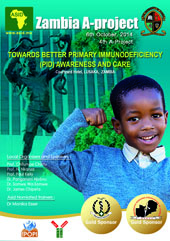Rasha H El-Owaidy, MD, PhD; lecturer of Pediatrics and Clinical Immunology. Faculty of Medicine, Ain Shams University, Cairo, Egypt
Introduction:Hyper immunoglobulin M (HIGM) syndrome results from a variety of genetic defects that affect the interaction between T-lymphocytes and B-lymphocytes leading to inability to switch from the production of antibodies of the IgM type to antibodies of the IgG, IgA or IgE types.
Nesrine Radwan, Lecturer of Pediatrics, Children’s Hospital, Faculty of Medicine, Ain Shams University, Cairo, Egypt.
Leukocyte adhesion defect (LAD) is a rare, autosomal recessive primary immunodeficiency, in which there is defective phagocyte aggregation at the site of infection due to the absence of surface integrins. It is characterized by recurrent infections, non purulent abscesses, defective wound healing and marked leukococytosis. The main problem results from an impaired step in the inflammatory process, namely, the emigration of leukocytes from the blood vessels to sites of infection, which requires adhesion of leukocytes to the endothelium. So far, three types of LAD I,II, and III have been identified. The diagnosis is based primarily on flow cytometric analysis of neutrophils for the surface expression of CD11, CD18 and CD15s on leucocytes. Treatment options include antibiotics and bone marrow transplantation if suitable donor is available.
Nesrine Radwan, assistant lecturer of pediatrics, faculty of medicine, Ain Shams University, Cairo, Egypt.
Severe combined immunodeficiency (SCID) is a life-threatening syndrome of recurrent infections, diarrhea, dermatitis, and failure to thrive. It is caused by numerous molecular defects that lead to severe compromise in the number and function of T cells, B cells, and occasionally natural killer (NK) cells. Clinically, most patients present before age of 3 months and death occurs around 2 years due to infection. SCID is considered a pediatric emergency because survival depends on expeditious stem cell reconstitution, usually by bone marrow transplantation (BMT).
Nesrine Radwan, assistant lecturer of pediatrics, faculty of medicine, Ain Shams University, Cairo, Egypt.
Background: HIES is a rare primary immunodeficiency characterized by recurrent eczema, skin abscesses, lung infections, eosinophilia and high serum levels of IgE. Two form of HIES have been described, including an autosomal dominant (AD, or type 1) and an autosomal recessive (AR, or type 2) form. These two forms share overlapping clinical and laboratory features. However, they also exhibit distinct clinical manifestations, courses and outcomes.



























